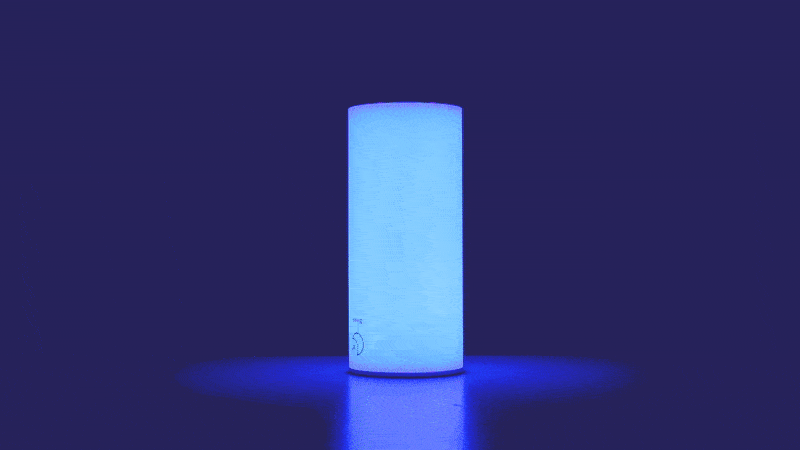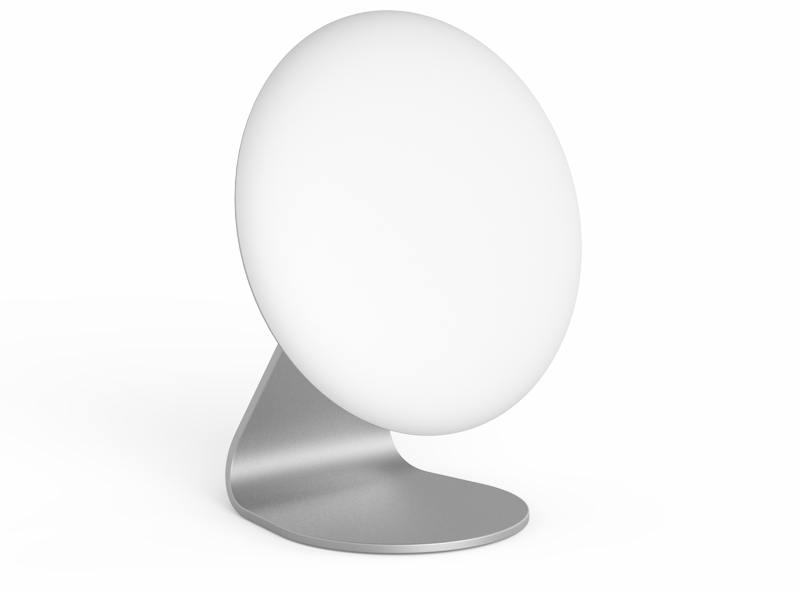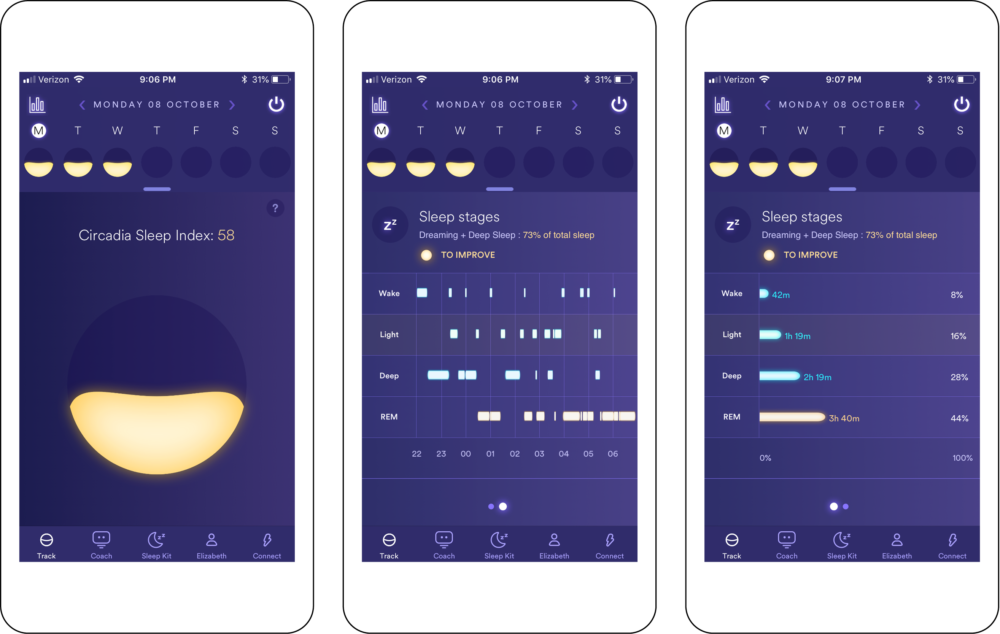A new device claims to go beyond sleep tracking to reset your circadian rhythm.
I am dreaming too much. That’s what Fares Siddiqui, cofounder of the company Circadia, tells me after its sleep tracker spends several nights perched at my bedside. When I first saw the long stretches of REM sleep — the stage of sleep when dreaming happens — in my data, I romanticized the results. I dream big, I thought. But Siddiqui says the pattern is a result of being either sleep-deprived or anxious. Oh.
Circadia is a startup focused on circadian rhythms, and the promise that if you can understand and control your daily patterns, you’ll sleep better: “a sleep lab on your bedside table,” pledges its marketing material. Most sleep trackers — devices on your wrist, on your mattress, or at your bedside — track your tossing and turning along with functions like your heart rate to tell you how much and how well you’ve slept. But typically, they don’t tell you what to do about it.
Siddiqui’s company, funded by healthy Kickstarter and Indiegogo campaigns, is developing a connected tracker, lamp, and app. It aims to set itself apart from the current wave of sleep trackers by offering both information on your own personal rhythm, and customized advice. “We want to tell you what time it is inside of your body,” Siddiqui says. He became passionate about the topic after dealing with his own insomnia and learning about NASA’s light experiments to help astronauts’ circadian rhythms.
Your circadian rhythm, your body’s natural 24-hour cycle, affects everything from sleep and jet lag to hormones and how well your drugs work. But different people’s internal clocks may run a little ahead or behind — maybe it’s midnight in your body when the clock says it’s only 10pm. For me, I’m hoping some circadian insight can help me feel more refreshed in the mornings. Other circadian-curious people might need to adjust to jet lag or shift work, or identify bad bedtime habits that are keeping them awake.
To learn about my own circadian biology, I let a premarket version of Circadia’s tracking device watch me sleep, I breakfasted by the glow of its lamp, and I gave personal details to its sleep-coaching app. I got an intriguing glimpse into the functioning of my body. But when it came to understanding the significance of my personal patterns, I was mostly left in the dark.
Surfing the wavelengths
In December, if all goes as planned, you’ll be able to buy Circadia’s $129 sleep tracker, which will be integrated with its lamp and app. For now, a rudimentary version of the app is free, and the lamp sells as a standalone for $79 — but it is a very handsome lamp, a sleek cylinder of blue light that morphs to red when you flip it over.
Those wavelengths are intended to reinforce my 24-hour rhythm, helping me sleep at night and be more alert during the day. When I lie down in bed, I’m supposed to leave that dim red light on for half an hour (even though my eyes are closed) to help myself fall asleep. The instructions also say 30 minutes of blue light in the morning will alleviate grogginess, so I eat a few breakfasts with the lamp lighting up my raisin bran.

I can’t tell if it makes me feel more awake, but according to Sabra Abbott, a neurologist at Northwestern University Feinberg School of Medicine, the ability of blue light to promote wakefulness and adjust our body clocks is well established. Blue wavelengths in sunlight naturally help our brains calibrate our clocks by preventing production of melatonin, a hormone that makes us sleepy. That’s why experts tell us not to stare at our phones, which emit blue light, at night in bed.
Abbott uses blue-wavelength light therapy and melatonin to treat patients with circadian disorders, who might naturally fall asleep very late or wake long before dawn. Light therapy is powerful enough that those with circadian disorders should be cautious with its timing, she adds. Someone whose clock is so shifted that they only fall asleep near dawn, for example, could make things worse by using blue light in the morning.
“We want to tell you what time it is inside of your body,” Siddiqui says.
That said, she doesn’t know of any reason to turn on a red lamp while you’re falling asleep. “It’s not so much the presence of red light that’s helpful, but the absence of blue light,” she says. Siddiqui says red light prevents melatonin suppression, which is true — but it’s no better than being in the dark. If you really wanted to take advantage of red light (and didn’t mind the creepiness factor), you could do all your evening activities by red light only. But Circadia’s red light, by design, is too dim for that.
I got yellow-zoned
The second part of Circadia’s setup is a sleep tracker, an elegantly designed hand-sized disc that snaps magnetically onto a stand. Siddiqui says it scans my body with radar looking for tiny movements to infer my heart rate and breathing. From that, it figures out which parts of the night I spent in wakefulness, light sleep, deep sleep, or REM sleep. In the company’s own comparison testing, Circadia outperformed wearable devices like the Fitbit.
I follow directions to set it roughly an arm’s length away from my bed and aim it at my torso. After some fussing on my phone to connect the tracker and app over wifi (so much for avoiding blue light), I hit “start” and lie down.

The first night, I feel self-conscious with the tracker staring at me. In the morning the app — a beta version that isn’t yet publicly available — says it took me 43 minutes to fall asleep.
Even after I get used to the tracker, the app seems to chastise me every morning, displaying a circle about half-filled with yellow and a middling “sleep index” score. The app also shows a timeline of my night that seems generally correct: It takes me a while to fall asleep. I sleep deeply at first, then shift into REM sleep in the early morning. As my husband gets ready for work, I alternate between dreaming and dozing.
Siddiqui says that later versions of the app will tell users how their circadian clocks align with the outside world. It will deliver personal recommendations for using the lamp and for changes to habits and sleep environments, so that people can recalibrate their internal clocks, sleep better, or combat jet lag. In the spring, users will also be able to sign up for advice from a human sleep coach or therapist.
For now, my only feedback comes from Siddiqui, who notices me waking up often. He also tells me that while an average person spends about a quarter of the night in REM sleep, for me it topped 40 percent on some nights, and 57 percent on one especially dreamy night. My body may be trying to catch up on missed rest by sacrificing deep and light sleep for extra REM.
But Abbott doesn’t think I should read too much into my results. Sleep tracking is an imperfect way to tell the time on someone’s internal clock; the best way is to measure melatonin production. In its most recent lab tests, Circadia was about 67 percent accurate at telling what sleep stage a person was in. So far, those lab tests have included only a small number of young, healthy males — not anyone with an actual sleep disorder.
Besides, people spend different amounts of time in certain sleep stages for many reasons, including normal variation and drug side effects — antidepressants reduce REM, for example. Circadia claims 1 in 3 people have rhythms that are out of sync, but Abbott says this is hard to know. Everyone falls somewhere on a spectrum from early bird to night owl, she says, which isn’t a disorder unless it interferes with life. But being told by an app that their sleep is abnormal might make people needlessly anxious.

you what needs improving. Courtesy of Circadia
Siddiqui says the tracker might discover that someone who has trouble sleeping has a normal circadian rhythm. For instance, me. I didn’t learn anything surprising about my body’s rhythms, but my chronically yellow gauge suggests I should take some steps toward better sleep hygiene (I’m guilty of reading in bed). In addition to tips for adjusting their rhythms, the app will offer users non-circadian solutions like meditation, mindfulness, relaxation and journaling.
Though these interventions aren’t as high-tech as Circadia’s other offerings, for many people they might be the best bet of all. “All of these behavioral recommendations to manage insomnia are really, long-term, much more effective than any medications that we have,” Abbott says. “So I think anything that can make that more accessible for the general public is great.” That means some people will soon be sleeping better — whether or not they’re dreaming big.












